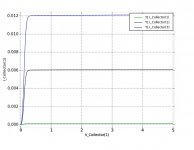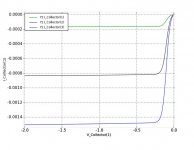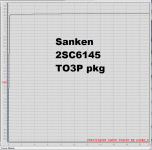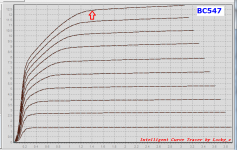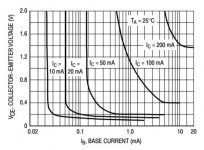In case you didn't know, replacement transistors like the NTE and ECG series are rebranded from existing industry standards, usually with an added price. You can probably find the original part numbers by using the replacement guide in reverse, and comparing specs, ie pick the best parts listed under NTE373 and NTE374. It looks like the NTE373 is actually a 2SC1904 and NTE374 is 2SA899.
In case you didn't know, replacement transistors like the NTE and ECG series are rebranded from existing industry standards, usually with an added price. You can probably find the original part numbers by using the replacement guide in reverse, and comparing specs, ie pick the best parts listed under NTE373 and NTE374. It looks like the NTE373 is actually a 2SC1904 and NTE374 is 2SA899.
Thanks for the info. I could not find 2SC1904 nor 2SA899 at Mouser/Digikey/Arrow/Newark. Obsolete? Who manufactured the 2SC1904 and 2SA899?
Of course they are obsolete. You have any idea how long NTE373/4 have been around? I was using them for replacement drivers more than 30 years ago. The $64k question is who is making the NTE parts now. The original Jap manufacturer certainly won’t be.
If you web search "2SC1904" you get things like
https://www.ebay.com/i/362255981825?chn=ps
implying they are Fujitsu numbers.
But as I said before, mje340/350 in the same package have very low "on voltage" at currents below 100mA. The fact that they can survive 500mA while 2SC1904 can not should not distract from their value. And there are other options. Limiting yourself to 50mA-100mA transistors overlooks several common parts.
https://www.ebay.com/i/362255981825?chn=ps
implying they are Fujitsu numbers.
But as I said before, mje340/350 in the same package have very low "on voltage" at currents below 100mA. The fact that they can survive 500mA while 2SC1904 can not should not distract from their value. And there are other options. Limiting yourself to 50mA-100mA transistors overlooks several common parts.
Some of the best performers (least quasi saturation at Ic = 8mA) are indeed big old whomper devices. For example:
_
Hi Mark,
Very true of the device for quasi sat, but Early voltage does not look that great, nor beta, at a minimum of 40, and capacitance is high, as expected for such a device. If we are talking about a device in the context of a VAS transistor and VAS transistor's quasi sat, this is not a good candidate for a VAS.
For me, priorities for a VAS transistor are its beta-VA product figure of merit and its ft. As long as it is used in a 2T VAS, its quasi saturation performance is a lesser concern, but one that should not be totally ignored.
I use the 2sc3503 virtually all the time in amplifiers with a 2T VAS and a 3 EF output triple with supply rails of 50V or more, and the IPS-VAS virtually never is the primary source of distortion pretty much all the way up to clipping. The primary source of distortion is virtually always the output stage.
I almost always test an amplifier for distortion at least three ways when using a 3 EF output triple. First, I take the negative feedback from a center tap of the predriver emitter follower emitter resistors with no load on the output stage. This pretty much shows how well the IPS-VAS-predriver works for distortion, and generally results in very low distortion, often difficult to measure even at 20 kHz.
Secondly, I take the feedback from the output in the conventional way and measure distortion under no load. This also usually results in very low distortion.
Finally, I measure it under various loads from 16 ohms down to 2 ohms. As expected, this is where distortion becomes more obvious, and demonstrates that the output stage dominates distortion, largely as a result of the current that it has to deliver and often dominated by crossover distortion.
A fourth approach I sometimes use is to operate the amplifier normally into a load and measure THD at the pre-driver emitter center tap. The distortion here is essentially that distortion which is required to largely cancel the distortion of the driver-output stage combination. It is somewhat like the inverse of the amplifier distortion when the distortion at the output is low, as is normally the case.
Cheers,
Bob
Hi Bob, please look at the plot again. The measured Ice vs Vce curve is ruler flat. That means very little Early effect. Here are the numerical values which I measured on my curve tracer.
2SC6145: Vearly = 1650 , Beta = 80 , product = 130K
2SC3503: Vearly = 560 , Beta = 200 , product = 110K
BTW the "champion" NPN for Beta*Vearly was the (discontinued) Toshiba 2SC5171. It had Vearly=1600 and Beta=180 for a product of 288K. A factor of 2.6 higher than the '3503. I know you don't mind using discontinued parts if they're really excellent, for example the 2SC3503.
_
2SC6145: Vearly = 1650 , Beta = 80 , product = 130K
2SC3503: Vearly = 560 , Beta = 200 , product = 110K
BTW the "champion" NPN for Beta*Vearly was the (discontinued) Toshiba 2SC5171. It had Vearly=1600 and Beta=180 for a product of 288K. A factor of 2.6 higher than the '3503. I know you don't mind using discontinued parts if they're really excellent, for example the 2SC3503.
_
Last edited:
Hi Bob, please look at the plot again. The measured Ice vs Vce curve is ruler flat. That means very little Early effect. Here are the numerical values which I measured on my curve tracer.
2SC6145: Vearly = 1650 , Beta = 80 , product = 130K
2SC3503: Vearly = 560 , Beta = 200 , product = 110K
BTW the "champion" NPN for Beta*Vearly was the (discontinued) Toshiba 2SC5171. It had Vearly=1600 and Beta=180 for a product of 288K. A factor of 2.6 higher than the '3503. I know you don't mind using discontinued parts if they're really excellent, for example the 2SC3503.
_
I looked at the actual datasheet for the 2sc6145. YMMV 🙂.
Cheers,
Bob
Hi all ... very interesting thread - thanks for sharing/discussing!
I noticed there was some interest in the KSC2690AY/KSA1220AY and it seems that they will both be available from Mouser (albeit the latter not until mid-August).
Cheers,
Jesper
I noticed there was some interest in the KSC2690AY/KSA1220AY and it seems that they will both be available from Mouser (albeit the latter not until mid-August).
Cheers,
Jesper
For power amps, even with good quasi-sat VAS, you are a volt or two short of saturating the output, so many amps use a boosted supply voltage for the VAS, making the VAS saturation voltage a non-issue. And low voltage (linear) amps probably use CFP outputs with gain so that the VAS need not slew all the way to the rails.
Last edited:
many amps use a boosted supply voltage for the VAS, making the VAS saturation voltage a non-issue.
Thread starter explained in posts #1 and #12 that this search for no-quasi-saturation NPNs was for a different application which is NOT a power amplifier's VAS. Have a look.
Hi Mark,
Can you confirm manufacturer brand of test result as your post #15 about BC547, here is your result: Its looks into quasi saturation.
On ON-semi BC547 datasheet i see it does not look too bad. On other hands, BC547B together 2SC1815, BC337 all they are usually used in industry as relays/contacts driver. If they too bad, they're will not used by designer due this thing cause efficiency decreasing.
Regards,
Can you confirm manufacturer brand of test result as your post #15 about BC547, here is your result: Its looks into quasi saturation.
On ON-semi BC547 datasheet i see it does not look too bad. On other hands, BC547B together 2SC1815, BC337 all they are usually used in industry as relays/contacts driver. If they too bad, they're will not used by designer due this thing cause efficiency decreasing.
Regards,
Attachments
Think I may have mentioned before but for lower QS at ~10mA try the BC337 instead.
I tend to use these in the lower stages of a cascoded VAS. Gets very high Early voltage and high gain. I'm surprised more people do not use cascodes.
I tend to use these in the lower stages of a cascoded VAS. Gets very high Early voltage and high gain. I'm surprised more people do not use cascodes.
Hi Mark,
Can you confirm manufacturer brand of test result as your post #15 about BC547, here is your result: Its looks into quasi saturation.
On ON-semi BC547 datasheet i see it does not look too bad. On other hands, BC547B together 2SC1815, BC337 all they are usually used in industry as relays/contacts driver. If they too bad, they're will not used by designer due this thing cause efficiency decreasing.
Regards,
Quasi saturation doesn't means, that the device is not working as switching bjt. Just just need to push more base current to reach the lower Vcesat. Of course there some more apropriate device for that.
BC547 can switch 100mA collector current with 0.8V Vcesat, if You apply 1mA base current. BC337 do the same with 0.5mA base current, or BC337 will reach 0.15Vcesat with 1mA base current.
Sajti
I have to admit that I'm in debt to the author of this topic and the Early effect topic too...
When i saw this topic for the first time i didn't realized its real benefit.Now i do and i think that these two topics are the most interesting topics i ever saw on Diyaudio.
When i saw this topic for the first time i didn't realized its real benefit.Now i do and i think that these two topics are the most interesting topics i ever saw on Diyaudio.
Does it happen for you to have available graphs for the fallowing transistors?:
BD140,
2sa992,
2sa1038,2sc2362
2sc1570, 2sa929
2sc2385,
2sb646, 2sb649,
2sd666, 2sd669,
2sc1775,
2sc3206,2sa1024,
2sc3421, 2sa1358,
2sa1266, 2sc3198,
?
BD140,
2sa992,
2sa1038,2sc2362
2sc1570, 2sa929
2sc2385,
2sb646, 2sb649,
2sd666, 2sd669,
2sc1775,
2sc3206,2sa1024,
2sc3421, 2sa1358,
2sa1266, 2sc3198,
?
Hi Sajti,
I means that BC547 can pass 10mA even 20mA Ic/1V Vce with no sign of quasi saturation.
With higher levels the quasi-sat is clearly as graphs line shows.
I means that BC547 can pass 10mA even 20mA Ic/1V Vce with no sign of quasi saturation.
With higher levels the quasi-sat is clearly as graphs line shows.
A 2T VAS with 10:1 degeneration will perform very well, even if there is a little bit of quasi sat in the VAS transistor. Always bear in mind that there are tradeoffs. Don't go too crazy about quasi sat characteristics at the expense of other performance issues. The last volt or so before clipping doesn't matter that much anyway. Always keep all of these things in perspective. It could be argued that the beta * VA figure of merit is more important overall than very low quasi sat voltage.
Cheers,
Bob
Cheers,
Bob
Hi Sajti,
I means that BC547 can pass 10mA even 20mA Ic/1V Vce with no sign of quasi saturation.
With higher levels the quasi-sat is clearly as graphs line shows.
I would say 20mA/1V is a bit optimistic, but 10mA/1V is fine. My opinion based on the left graph. The right graph satisfy your point of view.
Sajti
- Home
- Amplifiers
- Solid State
- Looking for a small signal NPN with no Quasi Saturation: MEASURED DATA
